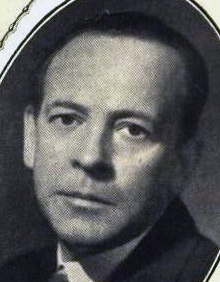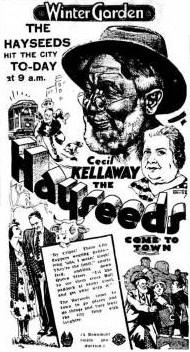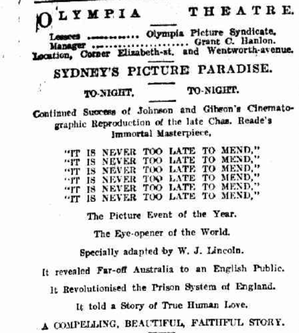Related Research Articles

Jedda, released in the UK as Jedda the Uncivilised, is a 1955 Australian film written, produced and directed by Charles Chauvel. His last film, it is notable for being the first to star two Aboriginal actors, Robert Tudawali and Ngarla Kunoth in the leading roles. It was also the first Australian feature film to be shot in colour.

James Francis "Frank" Hurley was an Australian photographer and adventurer. He participated in a number of expeditions to Antarctica and served as an official photographer with Australian forces during both world wars. He was the official photographer for the Australasian Antarctic Expedition and the Imperial Trans-Antarctic Expedition of 1914–16.

John Villiers Farrow, KGCHS was an Australian film director, producer, and screenwriter. Spending a considerable amount of his career in the United States, in 1942 he was nominated for the Academy Award for Best Director for Wake Island, and in 1957 he won the Academy Award for Best Adapted Screenplay for Around the World in Eighty Days. He had seven children by his wife, actress Maureen O'Sullivan, including actress Mia Farrow.

Cinesound Productions Pty Ltd was an Australian feature film production company. Established in June 1931, Cinesound developed out of a group of companies centred on Greater Union Theatres that covered all facets of the film process, from production to distribution and exhibition. Cinesound Productions established a film studio as a subsidiary of Greater Union Theatres Pty Ltd based on the Hollywood model. The first production was On Our Selection (1932), which was an enormous financial success.

In the Wake of the Bounty (1933) is an Australian film directed by Charles Chauvel about the 1789 Mutiny on the Bounty. It is notable as the screen debut of Errol Flynn, playing Fletcher Christian. The film preceded MGM's more famous Mutiny on the Bounty, starring Charles Laughton and Clark Gable, by two years.

Forty Thousand Horsemen is a 1940 Australian war film directed by Charles Chauvel. The film tells the story of the Australian Light Horse which operated in the desert at the Sinai and Palestine campaign during World War I. It follows the adventures of three rowdy heroes in fighting and romance. The film culminates at the Battle of Beersheba which is reputedly "the last successful cavalry charge in history". The film was clearly a propaganda weapon, to aid in recruitment and lift the pride of Australians at home during World War II. It was one of the most successful Australian movies of its day. It was later remade in 1987 as The Lighthorsemen.
Sons of Matthew is a 1949 Australian film directed and produced and co-written by Charles Chauvel. The film was shot in 1947 on location in Queensland, Australia, and the studio sequences in Sydney. Sons of Matthew took 18 months to complete, but it was a great success with Australian audiences when it finally opened in December 1949.

Frank Harvey was a British-born actor, producer, and writer, best known for his work in Australia.
The Squatter's Daughter is a 1933 Australian melodrama directed by Ken G. Hall and starring Jocelyn Howarth. One of the most popular Australian films of the 1930s, it is based on a 1907 play by Bert Bailey and Edmund Duggan which had been previously adapted to the screen in 1910.

Lovers and Luggers is a 1937 Australian film directed by Ken G. Hall. It is an adventure melodrama about a pianist who goes to Thursday Island to retrieve a valuable pearl.
Frank Beaumont "Beau" Smith, was an Australian film director, producer and exhibitor, best known for making low-budget comedies.
South West Pacific is a 1943 propaganda short Australian film directed by Ken G. Hall which focuses on Australia as the main Allied base in the South West Pacific area. Actors depict a cross section of Australians involved in the war effort.

The Hayseeds is a 1933 Australian musical comedy from Beaumont Smith. It centres on the rural family, the Hayseeds, about whom Smith had previously made six silent films, starting with Our Friends, the Hayseeds (1917). He retired from directing in 1925 but decided to revive the series in the wake of the box office success of On Our Selection (1932). It was the first starring role in a movie for stage actor Cecil Kellaway.
Splendid Fellows is a 1934 Australian film from director Beaumont Smith about an Englishman who comes to Australia. The cast includes Eric Colman, brother of Ronald Colman, and Sir Charles Kingsford Smith, who has a cameo as himself. It was Smith's last film.
Australia Calls is a 1923 Australian silent film directed by Raymond Longford commissioned by the Australian government to be shown at the British Empire Exhibition in Wembley Park, London, in 1924.
The Jungle Woman is a 1926 Australian film directed by Frank Hurley. It was shot partly on location in Thursday Island back to back with another Hurley feature, The Hound of the Deep (1926).
The Hound of the Deep is a 1926 British–Australian silent drama film directed by Frank Hurley and starring Eric Bransby Williams, Lilian Douglas and Jameson Thomas. Unlike many Australian silent films, a copy of it survives today.

It Is Never Too Late to Mend is a 1911 Australian feature-length silent film written and directed by W. J. Lincoln.
The Cup Winner is a 1911 Australian silent film directed by Alfred Rolfe. It is set against a backdrop of horseracing and the finale involves real footage from the 1911 Melbourne Cup.
The Monk and the Woman is a 1917 Australian silent film directed by Franklyn Barrett. It is considered to be lost.
References
- ↑ Anna Cater, 'Such Desirable Objects: Frank Hurley: Journeys into Papua', The Monthly, June 2008
- ↑ ""PEARLS AND SAVAGES."". The Register . Adelaide. 16 January 1922. p. 7. Retrieved 8 April 2012– via National Library of Australia.
- ↑ ""PEARLS AND SAVAGES."". The Register . Adelaide. 2 January 1922. p. 8. Retrieved 8 April 2012– via National Library of Australia.
- 1 2 Liz McNiven, 'Pearls and Savages – Curator's Notes', Australian Screen Online
- ↑ "PAPUAN COLLECTION". The Sydney Morning Herald . 24 February 1923. p. 18. Retrieved 8 April 2012– via National Library of Australia.
- ↑ "The TALKIE MAKERS". The Mail . Adelaide. 31 October 1931. p. 20. Retrieved 8 April 2012– via National Library of Australia.
- ↑ "AUSTRALIAN FILM". The Sydney Morning Herald . 23 February 1934. p. 5. Retrieved 8 April 2012– via National Library of Australia.
- ↑ Andrew Pike and Ross Cooper, Australian Film 1900–1977: A Guide to Feature Film Production, Melbourne: Oxford University Press, 1998, 132
- ↑ "Capt. Frank Hurley". Albany Advertiser . WA. 11 December 1928. p. 4. Retrieved 8 April 2012– via National Library of Australia.
- ↑ "COMPANY NEWS". The Sydney Morning Herald . 30 August 1927. p. 13. Retrieved 8 April 2012– via National Library of Australia.